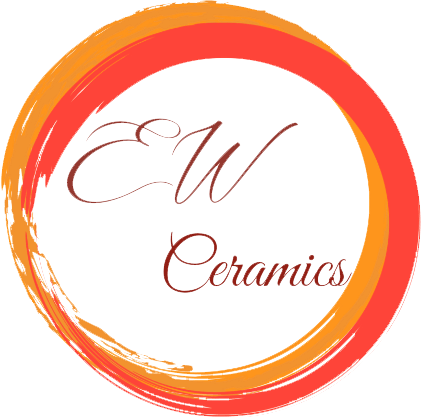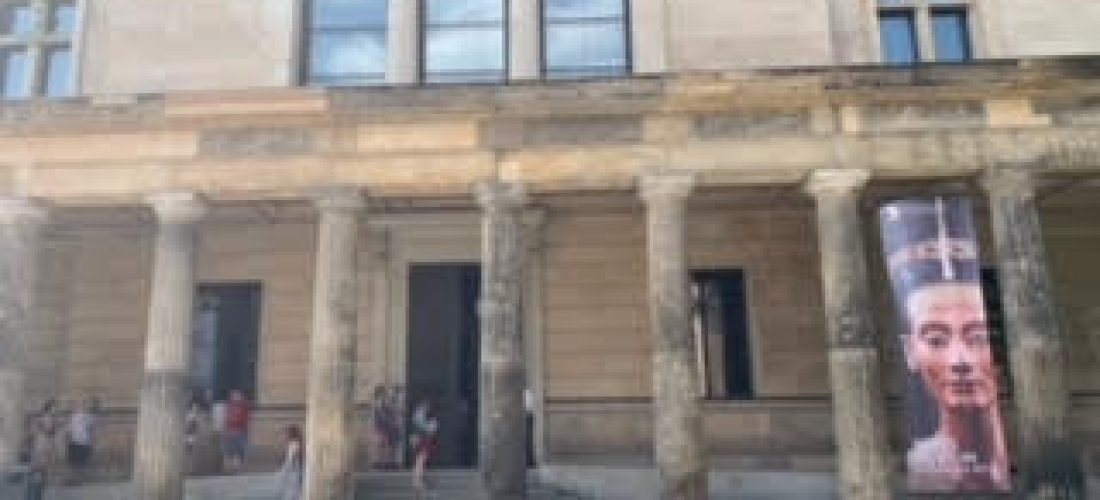Bodestraβe 1-3, Berlin, Germany
http://www.smb.museum/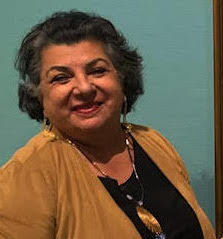
Copyright: Elizabeth Wiese
Visita realizada em Julho 2021 / Visited in July 2021
Prezado leitor, este blog bilingue foi escrito em Português e Inglês, sendo os textos apresentados primeiro em Português e a seguir em Inglês. Os textos em Inglês estão em itálico e vermelho para facilitar sua localização.
Dear reader, this bilingual blog was written in Portuguese and English, being the first texts presented in Portuguese followed by the English version. Texts in English are in italic and in red to make them easier to find.



No centro histórico de Berlim fica a ‘ilha dos museus’ que faz parte do patrimônio mundial cultural da UNESCO. O Neues Museu encontra-se nesta área geográfica de integração de vários museus. As fotos acima mostram museus localizados nesta área.
The Museum Island is located in the historic centre of Berlin and is a UNESCO World Heritage. The Neues Museum is part of this museums integration. The photos above show some buildings of museums in the area.

O interior do Museu Neues
The interior of the Neues Museum
O Neues Museu de Berlin tem duas importantes coleções permanentes que expõem tesouros arqueológicos do Museu Egípcio (Agyptisches Museum und Papyrussammlung) e do Museu de Pré-História e História moderna (Museum fur Vor-und Fruhgeschichte).
A coleção do Museu Egípcio apresenta artefatos que mostram as mudanças ocorridas naquela civilização durante quatro milênios. Já a coleção do Museu de Pré-História e História Moderna inclui peças encontradas na Europa e em partes da Ásia, produzidas desde a Idade da Pedra até a Idade Média.
The Neues Museum Berlin has two important permanent collections that exhibit archaeological treasures from the Egyptian Museum (Agyptisches Museum und Papyrussammlung) and the Museum of Prehistory and Modern History (Museum fur Vor-und Fruhgeschichte).
The Egyptian Museum collection features artefacts that show the changes that occurred in that civilisation over four millennia. The collection of the Museum of Prehistory and Modern History includes pieces found in Europe and parts of Asia, produced from the Stone Age to the Middle Ages.


O modelo do Distrito da Pirâmide do Rei Sahure (2496-2483 aC) ilustra a estrutura de um complexo funerário real do Império Antigo no Egito. Um complexo piramidal consiste em vários componentes: o templo do vale na margem do rio Nilo, onde começaram as cerimônias fúnebres; a calçada coberta com representações do reinado do rei; o templo mortuário e a própria pirâmide que formava os túmulos reais. As concepções das antigas crenças funerárias egípcias e noções da ordem mundial podem ser vistas dentro de tal monumento real. Enquanto a pirâmide garantia a aceitação do rei entre os deuses, o templo não apenas garantia o abastecimento do rei divino, mas também colocava a ordem mundial em suas mãos.
The model of the Pyramid District of King Sahure (2496-2483 BC) illustrates the structure of a royal funerary complex of the Old Kingdom in Egypt. A pyramid complex consists of several components: the valley temple on the bank of the river Nile, where the funeral ceremonies began; the covered causeway with depictions from the reign of the king; the mortuary temple and the pyramid itself that formed the actual tombs. The conceptions of ancient Egyptian funerary beliefs and notions of the world order may be found within such a royal monument. While the pyramid garantes the king’s acceptance among the gods, the temple not only secures the supply of the divine king but also places the world order in his hands.
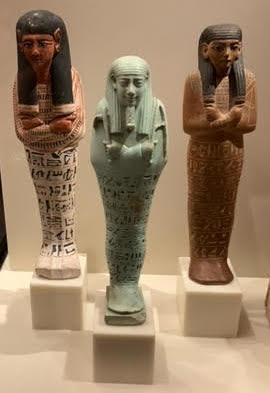
Modelos de sarcófagos Egipcios
Models of Egyptian sarcophagus
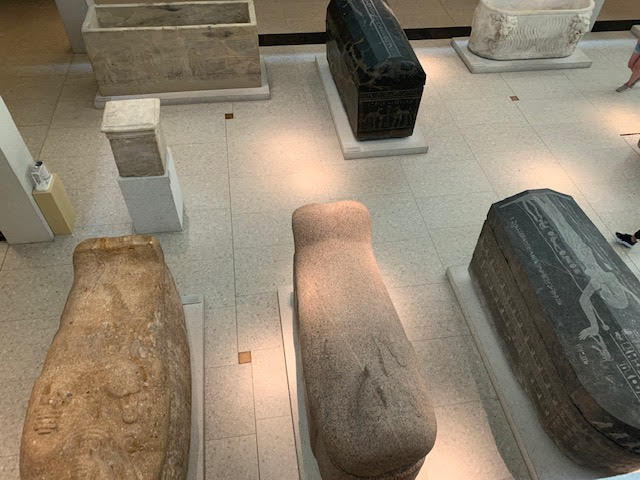
Sarcófagos Egipcios
Egyptian sarcophagus
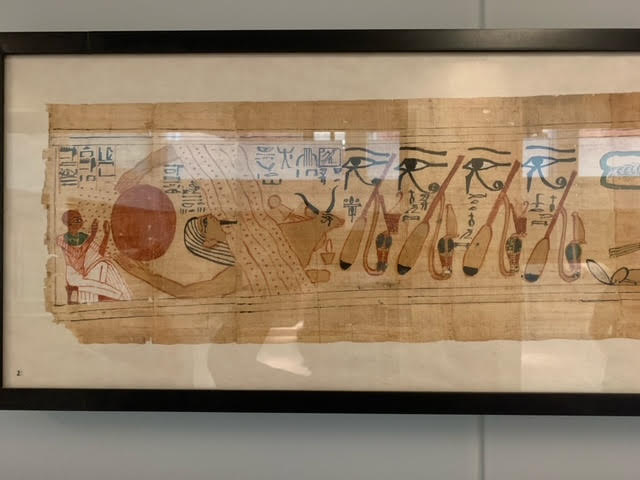
Papiro com desenhos relativos aos deuses Egípcios
Papyrus with drawings related to the Egyptian gods
A maior atração da exposição permanente do Neues Museu, em Berlin, é o belíssimo busto da rainha Nefertiti, esposa do faraó Akhenaten, que instituiu uma nova religião monoteísta de adoração ao Deus Sol. Nefertiti foi rainha de 1350s-1330s AC (há quase 3,5 mil anos), tendo o casal vivido na capital Amarna, localizada entre Cairo e Luxor.
The biggest attraction of the permanent exhibition at the Neues Museum, in Berlin, is the beautiful bust of Queen Nefertiti, wife of Pharaoh Akhenaten, who instituted a new monotheistic religion of worshiping the Sun God. Nefertiti was queen from 1350s-1330s BC (almost 3,500 years ago), and the couple lived in the capital Amarna, located between Cairo and Luxor.

O busto da Rainha Nefertiti esculpido em pedra
The bust of the Queen Nefertiti sculpted in limestone
O busto da Rainha Nefertiti foi esculpido em calcário e pintado, foi atribuído ao escultor Tutemes, em 1345 A.C., tendo sido encontrado em 1912 em seu atelier em Amarna, no Egito por uma equipe de arqueólogos alemães coordenada por Ludwig Borchardt. Neferititi foi uma mulher muito cultivada na antiguidade tornando-se um ícone da beleza feminina. Outras figuras humanas representativas de jovens, mulheres e rainhas também foram esculpidas em cerâmica e em bronze.
The bust of Queen Nefertiti, carved in limestone and painted, was attributed to the sculptor Tutemes, in 1345 BC, and was found in 1912 in his atelier in Amarna, Egypt, by a team of German archaeologists coordinated by Ludwig Borchardt. Neferititi was a highly cultivated woman in antiquity, becoming an icon of female beauty. Other human figures representing young people, women and queens were also sculpted in ceramics and bronze.
Outras belíssimas peças em cerâmica em bronze com origem no Egito estão expostas na coleção principal do museu.
Other beautiful models in bronze and in ceramics from Egypt are on display in the main collection of the museum.

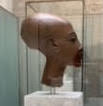
Cabeça da estátua de uma princesa
Head of a princess statue

Diversos vasos e artefatos Egípcios em cerâmica
Several Egyptian ceramic vases and artefacts

Estatuetas de figuras mulheres em pé em cerâmica
Ceramic statues of women standing
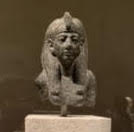
Parte superior da cabeça de uma rainha ou deusa com adereço em bronze
Upper part of the head of a queen or goddess with vulture headdress in bronze

Tigelas e vasos em bronze
Bronze bowls and vases
Na idade do bronze, de 1600-1050 aC, ocorreu um florescimento cultural em Chipre ao mesmo tempo que se deu a ascensão do Novo Reino no Egito e a civilização Micênica na Grécia continental. Na ilha conhecida como “Alashia” surgiu uma escrita silábica baseada no Minoan Linear A de Creta, que não foi decifrada até hoje. A ilha era composta de muitos pequenos estados com centros fortificados localizados principalmente perto da costa. As enormes fortificações parecem indicar ameaças externas e rivalidades internas. Não só o cobre era exportado em grandes quantidades, como a ilha era um centro de comércio do Mediterrâneo oriental. As cargas de navios mercantes afundados e os bens funerários em túmulos, túmulos escavados na rocha e túmulos de pedra abobadados testemunham a riqueza de Chipre. Após a queda do reino Minóico de Creta, os Micênicos usaram a ilha como base no comércio com o Levante. No século 11aC, como resultado de ameaças externas e da desintegração dos estados do Mediterrâneo oriental, houve um declínio no comércio que levou ao colapso da distinta civilização urbana cosmopolita da ilha.
In the late Bronze age, from 1600 – 1050 BC, a cultural blossoming began in Cyprus at the same time as the rise of the New Kingdom in Egypt and the Mycenacan civilisation in mainland Greece. On the island known as “Alashia” there emerged a syllabic script based on the MInoan Linear A of Crete, which remains undeciphered to this day. The island was made of many small states with fortified centres mostly located near the coast. The massive fortifications seem to indicate external threats and internal rivalries. Not only was copper exported in vast quantities, bur the island was altogether a hub of easternMediterranean trade. The cargoes of sunken merchant ships and the grave goods in shaft graves, rock-cut chamber graves and vaulted stone tombs bear witness to the wealth of Cyprus.Following the fall of the Minoan Cretan kingdom, the Mycenaeans used the island as a base for trade with the Levant. In the 11th century BC, as a result of external threats and the disintegration of the states of the eastern Mediterranean, there was a decline in trade leading to the collapse of the island’s distinctive cosmopolitan urban civilisation.
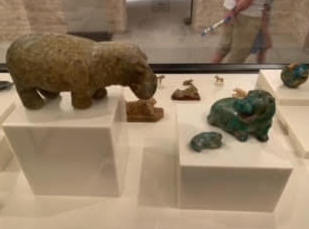
Figuras de animais em cerâmica
Animal figures in ceramics
Também se podem ser vistas ceramicas Greco-Romanas como as apresentadas abaixo.
You can also see Greco-Roman pottery like the ones shown below.

Cabeça feminina com véu e diadema em cerâmica terracota
Ceramic terracota female head with veil and diadem

Diversas mascaras em cerâmica
Diverse ceramic masks

Vasos sonoros em cerâmica
Sounded ceramic vases

Vasos, ânforas e diversos objetos em cerâmica feitos com Terra Sigilata
Ceramic vases, amphoras and diverse objects made with Terra Sigilata

Vasos em cerâmica
Ceramic vases

Jarras grandes e lindas em cerâmica
Beautiful ceramic large jugs

Utilitários em cerâmica do período arcaico: a perda da independência em 750 a 480 a.C.
Utilitarian in ceramic from the archaic period: the loss of independence in 750 to 480 B.C.
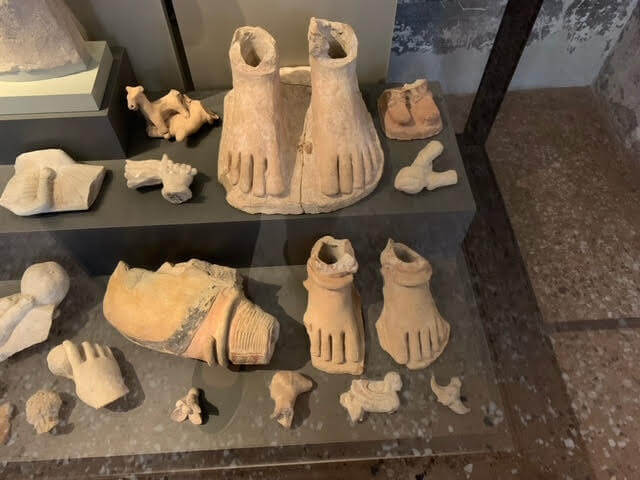
Partes do corpo humano em cerâmica
Human body parts in ceramic
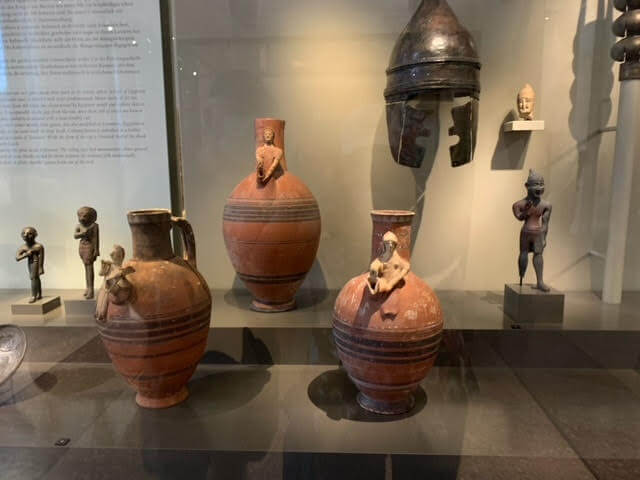
Vasos antropomórficos e estatuetas em cerâmica
Anthropomorphic ceramic vases and small statues

Vasos antropomórficos grandes em cerâmica com decoração em terra sigiiata
Large anthropomorphic ceramic vases with terra sigilata decoration
Para concluir este blog da apresentação de artefatos em cerâmica e bronze de culturas longínquas apresento o link do vídeo sobre o Neues Museu em Berlin. Veja o vídeo “From Nefertiti to Beuys- – Berlin’s museums / DW Documentary” no YouTube, falado em Inglês e parcialmente em Alemão com subtítulos em Inglês.
To conclude this blog presenting ceramic and bronze artefacts from distant cultures the link of the video of the Neues Museum in Berlin is presented. Watch the video “From Nefertiti to Beuys- – Berlin’s museums / DW Documentary” in YouTube, that is spoken in English and partially in German with English subtitles.
